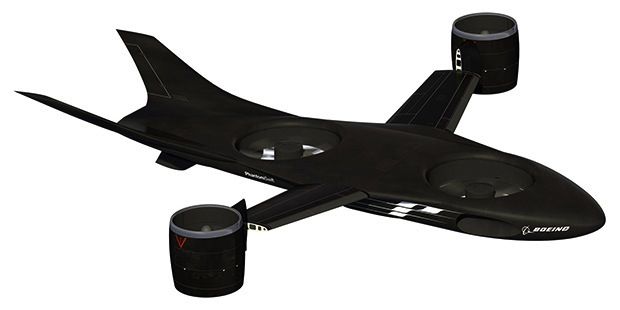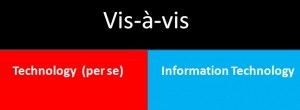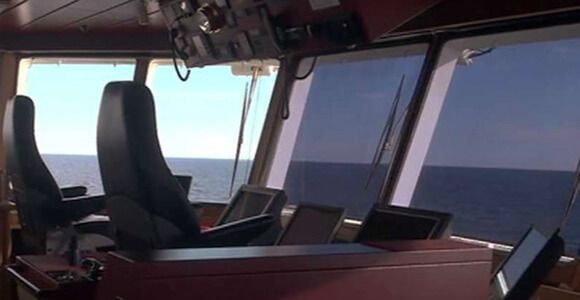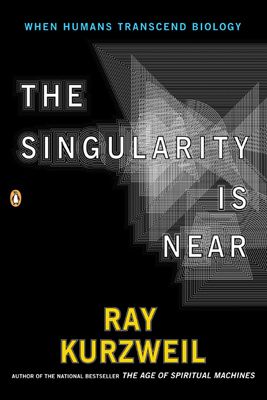Information Technology Vis-à-vis Technology Per Se! Is all “…technology…” an “…information technology…” only? Aren’t there other technologies above and beyond increasingly indispensable I.T.? The Most Authoritative and Functional Elucidation of the Technology Concept! By Mr. Andres Agostini at http://lnkd.in/bYP2nDC
With the advent of personal computers and the Internet, whenever anyone pronounces the word “…technology…” there is an unprecedented expectation to mean information technology. Something similar happens with the word system that goes, by far, further than just meaning “…computer system(s)…” But, let us just focus on technology now.
In addition of addressing I.T., it will also be coped with B.T., that is “…Business Technology …”, also called Business Technology Management (BTM).
Definitions stressing non-IT definitions of technology will be capitalized to show emphasis. By the way, in Canada, France and many other nations in the West, capitalized words do not ever have a negative connotation at all. As this prominent Blog and Forums reach out for a worldwide audience, I would suggest Earth’s readers consider the preceding in this paragraph.
According to the prestigious Royal Academy of the Spanish Language (RASL), technology entails: “… Set of theories and techniques that enable the practical use of scientific knowledge.… Treaty of technical terms…Language of a science or an art.…Set of instruments and procedures of a particular industrial sector or product.…” At http://bit.ly/1gI41lz
Conversely, the Spanish-language version available on Wikipedia indicates at http://bit.ly/1gRFB5z :
“…Technology is the set of scientifically ordered , expertise for designing and creating goods and services that facilitate adaptation to the environment and satisfying the essential needs as desires of humanity. It is a word of Greek origin, τεχνολογία formed by Techne ( τέχνη art or craft technique , which can be translated as skill) and ology ( λογία , the study of something). Although there are many very different technologies together, .… When I capitalized Technology may refer to both the theoretical discipline that studies common to all technologies and knowledge technology education, school discipline doomed to become familiar with the most important technologies…”
And also observes:
“.…However, the technology can also be used to protect the environment and prevent the growing needs cause a depletion or degradation of materials and energy on the planet or increasing social disparities.…In first approximation, the technology is the set of knowledge, skills, abilities and interrelated procedures for the construction and use of natural or artificial devices that translate the means to meet desires, wants, needs, skills and human compulsions . This definition is inadequate for which we have to analyze the functions , aims and epistemological aspects of technology.…”
And:
“…In prehistoric technologies have been used for essential needs (food, clothing, shelter, personal protection, social relationship, understanding of the natural and social world) , and also in history for personal and aesthetic pleasures ( sports, music, hedonism in all its forms ) and as a means to satisfy desires (symbolizing status, making weapons and the full range of drugs used to persuade and dominate people) artificial means…”
Also:
“…Non-technical functions of technology products.…After a while, the novel features of technology products are copied by other brands and cease to be a good sales pitch. Then take important consumer beliefs about other independent characteristics of its principal function as the aesthetic and symbolic.…Aesthetic function of technological objects…Beyond the essential fit between form and technical function , beauty is sought through shapes, colors and textures. Between two products equal technical performance and price, surely anyone choose to find more beautiful. Sometimes, if clothing , beauty can prevail on practical considerations. Often bought nice clothes even though we know that their clothing hidden details are not optimal , or that its duration will be short due to the materials used.…”
As well:
“…The most prominent and frequent technological objects manufactured by its symbolic function is the case of large buildings : cathedrals, palaces , giant skyscrapers. They are designed to belittle those inside (case of large atriums and high ceilings of cathedrals ) , dazzle with fancy displays (the palaces ) , instill awe and humility (for large skyscraper) . It is no coincidence that the terrorists of September 11, 2001 elected as the main target of their attacks on the Twin Towers in New York , site of the World Trade Organization and main command center of American economic power…”
In addition:
“…The Apollo Program was launched by President John F. Kennedy at the height of the Cold War, when the United States was apparently losing the space race against the Russians, to show the world of intelligence, wealth, power and technological capacity of States USA. The pyramids of Egypt are the most expensive example of the symbolic use of technologies…”
Additionally:
“…Methods technologies .… The technologies used, in general, different scientific methods , although experimentation is also used in science. The methods differ depending on whether industrial or industrial technologies artifact production , servicing , fulfillment of tasks or organization of any kind. A common method to all manufacturing technologies is the use of tools and instruments for the construction of artifacts. Technologies to provide services , such as electricity supply system make use of complex systems by qualified personnel…”
Equally:
“…Tools and Instruments .… The principal means for making artifacts are energy and information. The energy can give material form, location and composition are described by information. The first tools such as stone hammers and needles of bone, only facilitated and directed the application of force, by the people , using the principles of machines simples. 2 The use of fire, which changes the composition of making food more easily digestible, provides illumination enabling sociability beyond the daylight hours, provides heating and fends off ferocious beasts and animals, changed both the appearance and human habits…”
Moreover:
“…The tools incorporate more sophisticated information operation , such as strippers that can cut the sheath to the appropriate depth to pull it easily without damaging the metal core . The term ‘instrument’, however , is more directly associated with precision tasks , such as surgical instruments , and data collection , and electronic instrumentation and measurement instruments, nautical navigation and air navigation.…Machine tools are complex combinations of various governed tools (currently, many by computers) by information obtained from instruments, also incorporated in them…”
Furthermore:
“…According to science writer Asimov.…Inventing demanded firm work hard and thinking. Edison inventions drew custom and taught people who were not a matter of luck or brains. Because, while it is true that we enjoy today’s phonograph , cinema, electricity, telephone and a thousand other things, he made those of practical value…”
SOURCE : http://bit.ly/1gRFB5z
The Oxford English Dictionaries at http://bit.ly/1gB5SUY point out: “…Technology.…[is the] application of scientific knowledge for practical purposes, especially in industry.… and devices developed from scientific knowledge.…[TECHNOLOGY IS THE] BRANCH OF KNOWLEDGE DEALING WITH ENGINEERING OR APPLIED SCIENCES.…The money will be spent over the next four years on technology, science and mathematics.…Members of the public will often express caution about the advantages of new science and technology…”
Brackets are mine.
SOURCE: http://bit.ly/1gB5SUY
The Free Dictionary at http://bit.ly/1gI64pH argues that technology is “…The application of science, especially to industrial or commercial objectives.…THE SCIENTIFIC METHOD AND MATERIAL USED TO ACHIEVE A COMMERCIAL OR INDUSTRIAL OBJECTIVE.… Electronic or digital products and systems considered as a group: a store specializing in office technology…[Under] Anthropology [,] The body of knowledge available to a society that is of use in fashioning implements, practicing manual arts and skills, and extracting or collecting materials…”
AS WELL AS:
“.… The branch of knowledge that deals with applied science, engineering, the industrial arts, etc. .… THE APPLICATION OF KNOWLEDGE FOR PRACTICAL ENDS.…A TECHNOLOGICAL PROCESS, INVENTION, OR METHOD.…THE SUM OF THE WAYS IN WHICH SOCIAL GROUPS PROVIDE THEMSELVES WITH THE MATERIAL OBJECTS OF THEIR CIVILIZATION.… THE TERMINOLOGY OF A FIELD; technical nomenclature [That is to say by «nomenclature»: A system of names used in an art or science: the nomenclature of mineralogy…in a taxonomic classification: the rules of nomenclature in botany.…the terminology used in a particular science, art, activity, etc…]…”
Furthermore:
“.…Technology — the discipline dealing with the art or science of applying scientific knowledge to practical problems technology — the discipline dealing with the art or science of applying scientific knowledge to practical problems.…”
SOURCE: http://bit.ly/1gI64pH
On technology, the MacMillan dictionary at http://bit.ly/1gcflb3 argues that technology is the “…advanced scientific knowledge used for practical purposes, especially in industry…”
SOURCE: http://bit.ly/1gcflb3
The Latin definition of technology includes: “…art work [and] art/craft/trade [and] method/trick [and] skill/talent/craftsmanship…”
The technology (τεχνολογία ) definition in Greek dictionaries is as follows: [the] “…scientific and technical knowledge, the development of technology…”
Brackets are mine.
The Wikipedia French definition of technology at http://bit.ly/1l50zF6 indicates that “…The word technology is the study of tools and techniques. THIS TERM REFERS TO EVERYTHING THAT CAN BE SAID SEVERAL SPECIFIC HISTORICAL PERIODS, CONCERNING THE STATE OF THE ART IN ALL AREAS OF PRACTICAL SKILLS AND USE OF TOOLS. IT THEREFORE INCLUDES ART, CRAFT, CRAFTS, APPLIED SCIENCE AND POSSIBLY KNOWLEDGE. BY EXTENSION IT CAN ALSO REFER TO SYSTEMS OR METHODS OF ORGANIZATION THAT ALLOW SUCH TECHNOLOGY, AND ALL FIELDS OF STUDY AND THE RESULTING PRODUCTS…”
SOURCE: http://bit.ly/1l50zF6
Wikipedia’s English Definition Of Technology at http://bit.ly/1fDxJUC indicates “…word , teaching, scholarship… systematic treatment of grammar and rhetoric…a word that it does not have the time given in the today’s common sense…”
SOURCE: http://bit.ly/1fDxJUC
Wikipedia’s German Definition Of Technology at http://bit.ly/1ihYC4H observes that “…Expressly called Wolff also the architecture as a part of the technology. [And] Wolff sees the technology as a possible branch of philosophy .…[TECHNOLOGY IS THE] THE PRINCIPLE [ OF MODERN INDUSTRY ] , EVERY PROCESS OF PRODUCTION [ … ] DISSOLVE INTO ITS CONSTITUENT ELEMENTS , CREATED THE WHOLE MODERN SCIENCE OF TECHNOLOGY…”
Some brackets are mine, others are not.
Conversely:
“…Since the late 19th Century technology to the special field of technical sciences , which deals with the processing and machining procedures. One speaks of mechanical, chemical , food technology , etc. , limits the term so explicitly to the study of the production methods .… Technology: discipline of technical sciences, the material and technical side of the production process , the technological process .… In English , particularly American-style [English] , which actually existing word is techniques, an entirely uncommon as a counterpart to the German technology.… The range of meanings of English technology is much broader than that of technology [in German]: It ranges from technology to machine, tool, computer program to technical systems and procedures. Accordingly, in the translation from English into German caution should be exercised…”
Brackets are mine.
Likewise:
“…General Technology (trans-disciplinary art research and technology teaching) and the specific technologies ( the individual technical science disciplines ) .… A generally accepted definition of technology does not exist [in German as per Wikipedia].…You have to guess the meaning from the context in each case …”
SOURCE: http://bit.ly/1ihYC4H
Similarly, the Engineer’s Definition Of Technology at http://bit.ly/1gBexXk establishes that technology is the “…the scientific application of knowledge to solve practical problems and to make new inventions…”
SOURCE: http://bit.ly/1gBexXk
What is TECHNOLOGY? As per The Law Dictionary at http://bit.ly/1d1u6gc : “…INFORMATION APPLICATION TO DESIGN, PRODUCTION AND UTILIZATION OF SERVICES AND GOODS AND ORGANIZING HUMAN ACTIVITIES.…”
SOURCE: http://bit.ly/1d1u6gc
Similarly, technology, as per http://bit.ly/1g2iqcw , is “…THE BRANCH OF KNOWLEDGE THAT DEALS WITH THE CREATION AND USE OF TECHNICAL MEANS AND THEIR INTERRELATION WITH LIFE, SOCIETY, AND THE ENVIRONMENT, DRAWING UPON SUCH SUBJECTS AS INDUSTRIAL ARTS, ENGINEERING, APPLIED SCIENCE, AND PURE SCIENCE .…the sum of the ways in which social groups provide themselves with the material objects of their civilization .… discourse or treatise on an art or the arts.…systematic treatment of an art, craft, or technique.…science of the mechanical and industrial arts…”
SOURCE: http://bit.ly/1g2iqcw
A Full Definition of TECHNOLOGY at http://bit.ly/1gBfPlf posits that technology is the “.… the practical application of knowledge especially in a particular area : engineering [and] medical technology .… a capability given by the practical application of knowledge <a car’s fuel-saving technology> .… a manner of accomplishing a task especially using technical processes, methods, or knowledge <new technologies for information storage .… the specialized aspects of a particular field of endeavor <educational technology>…”
SOURCE: http://bit.ly/1gBfPlf
Equally, a definition of technology at and by http://bit.ly/1pcVmse ensues: ”… THE BODY OF KNOWLEDGE AVAILABLE TO A SOCIETY THAT IS OF USE IN FASHIONING IMPLEMENTS, PRACTICING MANUAL ARTS AND SKILLS, AND EXTRACTING OR COLLECTING MATERIALS .… TECHNOLOGIES MAY SEEM LIKE TOOLS OR IMPLEMENTS, BUT THEY ARE MORE THAN MERE EXTENSIONS OF HUMAN CAPACITY .… TECHNOLOGIES ARE NOT MERE EXTERIOR AIDS BUT ALSO INTERIOR TRANSFORMATIONS OF CONSCIOUSNESS .… WRITING IS A TECHNOLOGY THAT RESTRUCTURES THOUGHT …”
SOURCE: http://bit.ly/1pcVmse
Wikipedia’s Information technology definition at http://bit.ly/1l5866Y is “…Information technology (IT) is the application of computers and telecommunications equipment to store, retrieve, transmit and manipulate data, often in the context of a business or other enterprise. THE TERM IS COMMONLY USED AS A SYNONYM FOR COMPUTERS AND COMPUTER NETWORKS, BUT IT ALSO ENCOMPASSES OTHER INFORMATION DISTRIBUTION TECHNOLOGIES SUCH AS TELEVISION AND TELEPHONES. Several industries are associated with information technology, including computer hardware, software, electronics, semiconductors, internet, telecom equipment, e-commerce and computer services .… Humans have been storing, retrieving, manipulating and communicating information since THE SUMERIANS IN MESOPOTAMIA DEVELOPED WRITING IN ABOUT 3000 BC, BUT THE TERM INFORMATION TECHNOLOGY IN ITS MODERN SENSE FIRST APPEARED IN A 1958 ARTICLE PUBLISHED IN THE HARVARD BUSINESS REVIEW; authors Harold J. Leavitt and Thomas L. Whisler commented that ‘…the new technology does not yet have a single established name. We shall call it information technology .…’ Their definition consists of three categories: techniques for processing, the application of statistical and mathematical methods to decision-making and the simulation of higher-order thinking through computer programs…”
Equally:
“…BASED ON THE STORAGE AND PROCESSING TECHNOLOGIES EMPLOYED, IT IS POSSIBLE TO DISTINGUISH FOUR DISTINCT PHASES OF IT DEVELOPMENT: PRE-MECHANICAL (3000 BC – 1450 AD), MECHANICAL (1450–1840), ELECTROMECHANICAL (1840–1940) AND ELECTRONIC (1940–PRESENT). THIS ARTICLE FOCUSES ON THE MOST RECENT PERIOD (ELECTRONIC), WHICH BEGAN IN ABOUT 1940 …”
SOURCE: http://bit.ly/1l5866Y
Information technology as per the Merriam-Webster Dictionary Online at http://bit.ly/1nEXoWw , “…the technology involving the development, maintenance, and use of computer systems, software, and networks for the processing and distribution of data …”
SOURCE: http://bit.ly/1nEXoWw
IT (Information Technology) Definition at http://bit.ly/1mhZKJn argues: “… Stands for ‘Information Technology,’ and is pronounced ‘I.T.’ It refers to anything related to computing technology, such as networking, hardware, software, the Internet, or the people that work with these technologies. Many companies now have IT departments for managing the computers, networks, and other technical areas of their businesses. IT jobs include computer programming, network administration, computer engineering, Web development, technical support, and many other related occupations. Since we live in the “information age,” information technology has become a part of our everyday lives. That means the term ‘IT,’ already highly overused, is here to stay …”
SOURCE: http://bit.ly/1mhZKJn
SOURCE: Technology Sector Definition | Investopedia
Information Technology’s A Definition at http://abt.cm/1kJQeM4 is that ” …We use the term information technology or IT to refer to an entire industry. In actuality, information technology is the use of computers and software to manage information. In some companies, this is referred to as Management Information Services (or MIS) or simply as Information Services (or IS). The information technology department of a large company would be responsible for storing information, protecting information, processing the information, transmitting the information as necessary, and later retrieving information as necessary …”
SOURCE: http://abt.cm/1kJQeM4
Defining ”…Business Technology …” (B.T.) at eHow via http://bit.ly/1dekhfj : “… Business technology involves the use of mechanisms that enable business organizations to process inputs and outputs more effectively and efficiently. It impacts every area of the business, assisting employees in maintaining smooth operations among departments throughout the business …”
SOURCE: http://bit.ly/1dekhfj
In the same way:
Business Technology vs. Information Technology at http://bit.ly/1iEGaEa argues”
“… As it turns out, the simple search of ‘business technology’ on Google returns over 21 million results! .… With the growing pervasiveness of technology over the past decade, THERE ARE FEW SCENARIOS WHEREBY TECHNOLOGY IS NOT BEING LEVERAGED TO ENABLE THE BUSINESS .… BUSINESS IS TECHNOLOGY AND TECHNOLOGY IS BUSINESS .… CLEARLY THIS IS MUCH MORE THAN A SEMANTIC RELATIONSHIP. THE CHALLENGE FOR ORGANIZATIONS IN THE FUTURE WILL NOT BE THE BASED ON THE AVAILABILITY OF TECHNOLOGY, BUT RATHER ON THE MANAGEMENT AND UTILIZATION OF THE TECHNOLOGY TO DRIVE BUSINESS ADVANTAGE …”
Additionally:
” … As the lines between business and technology continue to converge, you have to think about the preparedness of the next generation business technology leaders and whether they are equipped to effectively manage the complexities of business technology .… Many CIO’s when asked about their labor force, raise significant concerns about the shortage of skilled IT professionals such as software engineers, however, I believe the shortage has much more of an impact from a management perspective. Given the increase in technology spend which can be as high as 40 to 50 percent in some industry sectors, ABOUT ONE-THIRD OF CIO’S (AND THIS NUMBER IS INCREASING), CONTINUE TO REPORT TO THE CFO. THIS REPORTING RELATIONSHIP WILL FURTHER DEMAND A CERTAIN LEVEL OF FINANCIAL SAVVY, WHICH IS TYPICALLY NOT A STRONG ATTRIBUTE OF TODAY’S TECHNOLOGY MANAGERS .… ”
SOURCE: http://bit.ly/1iEGaEa
What is Business Technology? through Yahoo Answers at http://yhoo.it/1g2t3ME : ” … Business Technology Management (BTM) is a management science which aims to unify business and technology business strategies with the aim of extracting the full potential value of business technology solutions .… This dimension refers to the institution of a set of robust, flexible processes, broadly defined as: Quality of Business Practice: Doing the right things .… Efficiency: Doing the right things efficiently .… Effectiveness: Doing the right things well .… Organization: This refers to the establishment of appropriate organizational structures – essentially, establishing a structure in which every member understands the scope and responsibilities of his or her role, and understands the structure of which they are a part .… Information: This emphasizes the value that the effective, timely provision of information has in enabling effective decision making, and puts into place a structure of data and metrics to allow their best use .… Technology: Tying the other three dimensions together is the idea that technology plays a vital role in all processes. The appropriate use of technology can enable timely information sharing, improve co-ordination between members of an organization and makes processes easier to execute …”
By the same token:
” … Business Technology Management defines 17 such capabilities, grouped into four functional areas .… Governance and Organization: These capabilities ensure that business technology decisions are effectively identified and executed – essentially, developing an organizational structure that meets the needs of the business, gives consideration to regulation and manages risk appropriately .… Managing Technology Investments : These capabilities ensure that the enterprise understands its current IT capabilities, what is currently available and what it is working on for the future. They also ensure that executives select the best technology initiatives to advance the objectives of the business .… Strategy & Planning: These capabilities ensure that Information Officers make the most appropriate moves to synchronize technology and business, both reducing complexity and planning for future developments .… Strategic Enterprise Architecture: These capabilities ensure that appropriate information exists that can describe current and future business environments, and enable executives to make plans and implement strategies that will simplify the business technology environment within the enterprise …”
SOURCE : http://yhoo.it/1g2t3ME
As well:
Wikipedia’s List of technologies — Wikipedia, the free encyclopedia at http://bit.ly/1gBkwM0 includes verbatim:
Practical Technologies
c. 2 mya : Simple stone technology
c. 1.5 mya : Fire creation
c. 1.2 mya years ago : Stone tools
c. 110,000 years ago : Fur clothing
c. 43,000 years ago : Mining
c. 40,000 years ago : Logboat
c. 36,000 years ago : Bone flute
c. 32,000 BC : Animal domestication
c. 30,000 years ago : String
c. 30,000 years ago : Painting
c. 23,000 BC : Ceramics
c. 18,000 BC : Sewing
c. 15,000 BC : Rope
c. 10,000 BC : Plant domestication
c. 8000 BC : Brick
c. 8000 BC : Spindle
c. 7000 BC : Metalworking
c. 6000 BC : Salt cultivation
c. 5000 BC : Leather
c. 5000 BC : Irrigation
c. 4500 BC : Equestrianism
c. 4000 BC : Weaving loom
c. 4050 BC : Wheel
Military Technologies
c. 1.6 mya : Acheulean hand axes
c. 400,000 years ago : Spear and Javelin
c. 25,000 BC : Dart thrower
c. 18,000 years ago : Boomerang
c. 12,000 BC : Mace
c. 9200 BC : Microliths
c. 9000 BC : Bow
c. 7000 BC : Defensive wall
l
Astronomical Technologies
c. 5000 BC : Megaliths
c. 5000 BC : Sundial
Classical Era
(3500 BC — 500 AD)
Practical Technologies
c. 3500 BC : Writing systems
c. 3000 BC : Mummification
c. 3000 BC : Papyrus
c. 3000 BC : Ard plough
c. 3000 BC : Wheel
c. 3000 BC : Glass making
c. 3000 BC : Galley
c. 3000 BC : Pottery
c. 2800 BC : Metallurgy/Bronze forging
c. 2700 BC : Plumbing
c. 2500 BC : Abacus
c. 2000 BC : Iron Smelting
2nd millennium BC : Arch
c. 1700 BC : Alphabet
c. 1500 BC : Glass making
c. 11th century BC : Steel
c. 800 BC : Saddle
c. 710 BC : Lock
c. 600 BC : Aqueduct
c. 600 BC : Archimedes’ screw
6th century BC : Caliper
c. 515 BC : Crane
c. 325 BC : Odometer
3rd century BC : Watermill
c. 200–300 BC : Block and tackle
c. 100–500 BC : Horseshoe
c. 100 BC : Paper
50 AD : Aeolipile
Military Technologies
c. 3000 BC : Sword
c. 2600 BC : Chariot
c. 800 BC : Ram bow
8th century BC : Incendiary arrows
c. 700 BC : Polyreme
5th century BC : Crossbow
399 BC : Catapult
359–336 BC : Pike
c. 130 BC : Stirrup
50 BC : Scorpio
Astronomical Technologies
c. 4000 BC : Calendar
c. 1500 BC : Water clock
c. 1500 BC : Sundial
c. 1100 BC : Gnomon
c. 2300 BC : Map
c. 300 BC : Hemicycle
c. 130 BC : Orrery
Medieval Era
(500 AD — 1450 AD)
Practical Technologies
876 AD : Zero
9th century AD : Windmill
Military Technologies
c. 672 AD : Greek fire
c. 1350 AD : Longsword
c. 1400 AD : Plate armour
c. 1500 AD : Supergun
Astronomical Technologies
1283 AD : Mechanical clock
Renaissance Era
(1450 — 1800 AD)
Practical Technologies
1656 AD : Pendulum clock
Military Technologies
c. 1300 firearms
Astronomical Technologies
SOURCE: http://bit.ly/1gBkwM0
Please note, too, the Wikipedia’s list of emerging technologies at http://bit.ly/1gIoJlw as it literally follows:
” … This is a list of currently emerging technologies, which contains some of the most prominent ongoing developments, advances, and innovations in various fields of modern technology. Emerging technologies are those technical innovations which represent progressive developments within a field for competitive advantage …”
Contents
1 Agriculture
2 Biomedical
3 Displays
4 Electronics
5 Energy
6 IT and communications
7 Manufacturing
8 Materials science
9 Military
10 Neuroscience
11 Robotics
12 Transport
Agriculture
Agricultural robot
Closed ecological systems
Genetically modified food
Meat incubator
Creating synthetic meat products
In vitro meat Research and development
Precision agriculture
Soylent (food substitute)
Vertical farming
Biomedical
Artificial uterus
Extracorporeal pregnancy,
Reprogenetics,
same-sex procreation
Body implants, prosthesis Trials, from animal (e.g., brain implants) to human clinical (e.g., insulin pump implant), to commercial production (e.g. pacemaker, joint replacement, cochlear implant)
Brain implant, retinal implant
Cryonics Hypothetical, research
Life extension
Genetic engineering
Eliminating genetic disorders (gene therapy)
Genetically modified food, genetic pollution
Hibernation or suspended animation
Life extension, Strategies for Engineered Negligible Senescence
Nanomedicines
Oncolytic Virus
Regenerative medicine
Robotic surgery
Stem cell treatments
Trial spinal cord injury treatment (GERON), cultured cornea transplants.
Tissue engineering
Organ printing
Virotherapy
Gene therapy, cancer therapy
Virotherapy, Oncolytic Virus
Vitrification or cryoprotectant Hypothetical, some
Holography (Holographic display, Computer-generated holography) Diffusion
Organic light-emitting transistor
Phased-array optics
Quantum dot display Diffusion
(And a long so-forth).
SOURCE: http://bit.ly/1gIoJlw
And, now:
It is highly advisable for the avid reader to notice what a lexicon, researched by 200 American and Canadian Philosophiae doctors, states on its preface.
Subsequently, please note:
The American Heritage Dictionary’s Introduction (fourth edition, 2000) by Joseph P. Pickett, Executive Director, literally indicates, to further illustrate the reader, [54]:
“…This Fourth Edition of The American Heritage Dictionary combines the best of traditional making with key innovations that afford new ways of looking at our language… This edition has nearly 10,000 new words and senses that reflect the rapid pace of change in the English language today. Technological innovations in computing and communications along with advances in the sciences have been especially rich sources of development in the lexicon (for example, bit map, domain name, and raster in computing; dark matter, photonics, and yoctosecond in science). Medicine and medical research continue to produce an astonishing array of new terms for chemicals and substances (endostatin, leptin, transfatty acid), for disorders and infectious agents (Asperger’s syndrome, erectile dysfunction, hantavirus), for treatment (cocktail, molecular knife, xenotransplant), and for a variety of creations and discoveries (designer gene, enteric nervous system, microsleep) .… In addition, continuing social change in postindustrial society has given rise to expressions that describe new business practices (buyback, microcredit, reverse mortgage), a changing workplace (face time, job-share, mommy track), and evolving political positions and governmental policies (family leave, term limit, workfare). New sports terms have arisen (clap skate, five hole, skyboard), as have words for new educational practices (charter school, distance learning, homeschool). The names of foods from other cultures continue to be adopted (baba gannouj, garam masala, quesadilla). A host of new cultural developments has produced a host of new compound cords (assisted living, poetry slam, shock jock). And English speakers continue to be an exuberance force in creative coinage (bloviate, newbie, wannabe) .… To ensure accuracy in the coverage of our rapidly changing vocabulary, we have worked closely with distinguished consultants in a wide variety of specialized fields, including anthropology, astronomy, genetics, immunology, philosophy, and physics, to name but a few. We have also gone to great lengths to make our biological and geographic entries as timely as possible. Many new biographical entries have been added, especially in the areas of sports, music, film-making, and literature. To the geographic entries we have added new country names, such as Myanmar and the Republic of Congo, and newly prominent places such as Kosovo …”
From the preceding you can infer the plethora of specialized technologies there is.
SOURCE: The American Heritage Dictionary’s (fourth edition, 2000)— ISBN 0−395−82517−2
IMPORTANT:
As a review, recap and synthesis of all of the work above, I suggest the reader give a careful consideration to the following citations:
1.- “ …This term refers to everything that can be said several specific historical periods, concerning the state of the art in all areas of practical skills and use of tools. It therefore includes art, craft, crafts, applied science and possibly knowledge. By extension it can also refer to systems or methods of organization that allow such technology, and all fields of study and the resulting products…”
2.- “.…[Technology is the] the principle [ of modern industry ] , every process of production [ … ] dissolve into its constituent elements , created the whole modern science of technology…”
3.- “…Information application to design, production and utilization of services and goods and organizing human activities.…”
4.- “…the branch of knowledge that deals with the creation and use of technical means and their interrelation with life, society, and the environment, drawing upon such subjects as industrial arts, engineering, applied science, and pure science…”
5.- “… The body of knowledge available to a society that is of use in fashioning implements, practicing manual arts and skills, and extracting or collecting materials .… Technologies may seem like tools or implements, but they are more than mere extensions of human capacity .… Technologies are not mere exterior aids but also interior transformations of consciousness .… Writing is a Technology that Restructures Thought …”
6.- “.…the Sumerians in Mesopotamia developed writing in about 3000 BC, but the term information technology in its modern sense first appeared in a 1958 article published in the Harvard Business Review …”
7.- “…Based on the storage and processing technologies employed, it is possible to distinguish four distinct phases of IT development: pre-mechanical (3000 BC – 1450 AD), mechanical (1450–1840), electromechanical (1840–1940) and electronic (1940–present). This article focuses on the most recent period (electronic), which began in about 1940 …”
8.- “ … there are few scenarios whereby technology is not being leveraged to enable the business .… business is technology and technology is business .… Clearly this is much more than a semantic relationship. The challenge for organizations in the future will not be the based on the availability of technology, but rather on the management and utilization of the technology to drive business advantage .…”
9.- “ …about one-third of CIO’s (and this number is increasing), continue to report to the CFO. This reporting relationship will further demand a certain level of financial savvy, which is typically not a strong attribute of today’s technology managers .… ”
CONCLUSION:
As I will explain briefly later, there is only one global “…technology…” since time immemorial. Yes, there is I.T. and also B.T.
By way of example, there are specialized technologies (by their own rights) in fields, among innumerable others, such as: Agriculture, cryonics, life extension, lenetic engineering, eliminating genetic disorders (gene therapy) , genetically modified food, genetic pollution, hibernation or suspended animation, brain implant, retinal implant, so forth.
With the access and research of offline and online dictionaries, I will hereby offer a womb-to-tomb 89-word definition of technology.
The reader should bear in mind that “…engineering …”, in most instances, can operate as a synonym to “ … technology …”
Dictionaries above defined “…engineering …” as “ … The application of scientific and mathematical principles to practical ends such as the design, manufacture, and operation of efficient and economical structures, machines, processes, and systems …. The profession of or the work performed by an engineer …. Skillful maneuvering or direction: geopolitical engineering; social engineering …”
Back to my own definition now:
“… Technology is instituted in order to solve practical problems (both mild and complex ones) ─ especially in industry, commerce, economy, science, technology, society, and politics (including geopolitics) ─, the methodical practical application of the scientific method, mathematical principles, practical sciences and material used to achieve a commercial or industrial objective and beyond, as well as to achieve practical ends such as the design, manufacture, and operation of efficient and economical structures, machines, processes, and systems …. The profession of or the work performed by any engineer …”
If you want a briefer definition, please see this: ” … the methodical and systematic application of science in order to solve practical problems …”
Accordingly:
Kindly please remember the ensuing quotation:
“…The heritage of the past is the seed that brings forth the harvest of the future…” ─ Inscription from statuary pedestal at National Archives in Washington
Regards,
Mr. Andres Agostini
Risk-Management Professional Futurologist
and Entrepreneurial Success Consultant
http://lnkd.in/bYP2nDC








